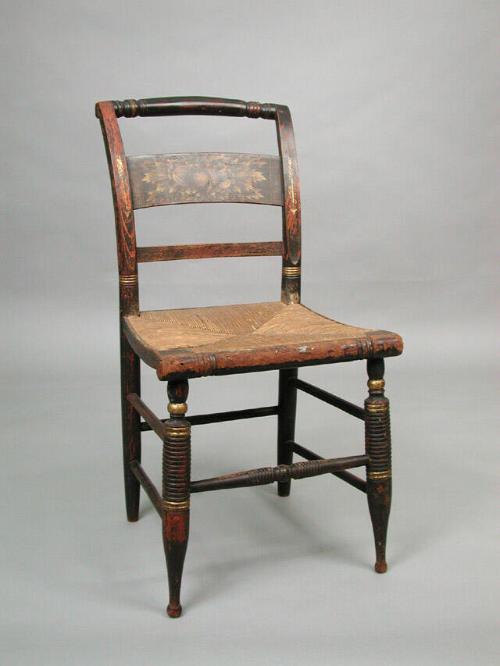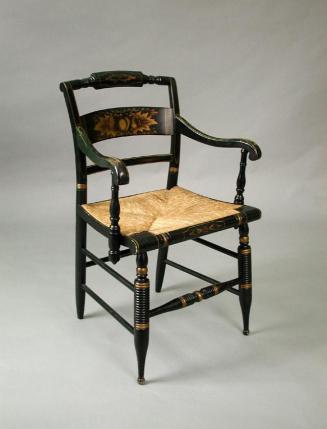Side Chair
Furniture MakerMade by
Lambert Hitchcock
(American, 1795 - 1852)
Date1825-1832
MediumMaple, rush
DimensionsPrimary Dimensions (overall height x width x depth): 33 7/8 x 17 1/16 x 19 1/2in. (86 x 43.3 x 49.5cm)
ClassificationsFurniture
Credit LineGift of the estate of Miss Adele R. Hough
Object number1970.24.4
DescriptionPainted side chair in the Empire, or late neoclassical, style, with a turned crest rail, front legs, and stretchers, and a trapezoidal rush seat. The back of the chair is formed by a turned crest rail atop two stiles. Below the crest rail are two slats between the stiles; the top slat is taller than the slender slat below. The crest rail and slats are bowed back slightly in the center. Above the seat, each stile is curved back and has flat front and side surfaces over a band of four turned rings just above the seat. Below the seat, each stile forms a cylindrical back leg over a tapered foot. Each front leg has a block on top that supports the front corners of the trapezoidal rush seat. The rush seat sits just inside four seat rail facings that cover all four sides of the rush. The side seat rail facings are bowed down in the center and have a scrolled front that correspond to the semi-circular scroll of the front seat rail facing. Each front leg is straight, but raked slightly out from top to bottom. The leg is turned with eighteen rings of the same size over a tapered ankle, and a small, ball foot. The front of the chair has a single stretcher turned with ring and tapered forms that connects the two front legs. Each side of the chair has two plain, turned stretchers. The back of the chair has a single plain, turned stretcher.
Painted Decoration. The frame of the chair is painted black with gold bands outlining the turned rings on the crest rail, stiles, portions of the front legs, and front stretcher. The front of each stile has stenciled gilt decoration consisting of an arrow and a vine. The front of the top slat has a gilt stenciled decoration of fruit, grapes and leaves, with a geometric border at either side. The lower slat is outlined with two thin gold lines.
Condition. The black and gold painted decoration is flaking over all the surfaces of each chair frame, with only limited flaking on top slat. The black paint or any gilded decoration is completely worn away on the front seat rail facing. Additional nails have been added to the seat rail facings.
Design and Construction Details: The crest rail is joined to each stile with a lap joint at the top back of the stile and crest rail; this joint is secured with a nail or screw through the back that is concealed with filler. Each slat is tenoned into the upper stiles. The seat is constructed of four hidden seat rails that are tenoned into the stiles at the back and into a block at each front corner of the seat. The blocks at the front of the seat are supported on a tenon at the top of the front legs. The rush is woven around this frame. The seat rail facings are nailed in place over the hidden seat rails on all four sides of the seat. The stretchers are tenoned into the legs.
Painted Decoration. The frame of the chair is painted black with gold bands outlining the turned rings on the crest rail, stiles, portions of the front legs, and front stretcher. The front of each stile has stenciled gilt decoration consisting of an arrow and a vine. The front of the top slat has a gilt stenciled decoration of fruit, grapes and leaves, with a geometric border at either side. The lower slat is outlined with two thin gold lines.
Condition. The black and gold painted decoration is flaking over all the surfaces of each chair frame, with only limited flaking on top slat. The black paint or any gilded decoration is completely worn away on the front seat rail facing. Additional nails have been added to the seat rail facings.
Design and Construction Details: The crest rail is joined to each stile with a lap joint at the top back of the stile and crest rail; this joint is secured with a nail or screw through the back that is concealed with filler. Each slat is tenoned into the upper stiles. The seat is constructed of four hidden seat rails that are tenoned into the stiles at the back and into a block at each front corner of the seat. The blocks at the front of the seat are supported on a tenon at the top of the front legs. The rush is woven around this frame. The seat rail facings are nailed in place over the hidden seat rails on all four sides of the seat. The stretchers are tenoned into the legs.
Status
On view












